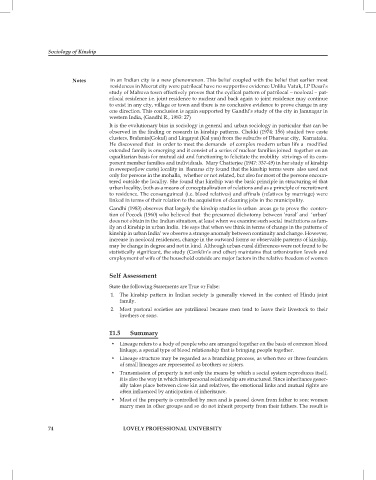Page 80 - DSOC402_SOCIOLOGY_OF_KINSHIP_ENGLISH
P. 80
Sociology of Kinship
Notes in an Indian city is a new phenomenon. This belief coupled with the belief that earlier most
residences in Meerut city were patrilocal have no supportive evidence Unlike Vatuk, I.P Desai’s
study of Mahuva town effectively proves that the cyclical pattern of patrilocal – neolocal – pat-
rilocal residence i.e. joint residence to nuclear and back again to joint residence may continue
to exist in any city, village or town and there is no conclusive evidence to prove change in any
one direction. This conclusion is again supported by Gandhi’s study of the city in Jamnagar in
western India, (Gandhi R., 1983: 27)
It is the evolutionary bias in sociology in general and urban sociology in particular that can be
observed in the finding or research in kinship patterns. Chekki (1974: 156) studied two caste
clusters, Brahmin(Gokul) and Lingayat (Kal yan) from the suburbs of Dharwar city, Karnataka.
He discovered that in order to meet the demands of complex modern urban life a modified
extended family is emerging and it consist of a series of nuclear families joined together on an
equalitarian basis for mutual aid and functioning to felicitate the mobility strivings of its com-
ponent member families and individuals. Mary Chatterjee (1947: 337-49) in her study of kinship
in sweeper(low caste) locality in Banaras city found that the kinship terms were also used not
only for persons in the mohalla, whether or not related, but also for most of the persons encoun-
tered outside the locality. She found that kinship was the basic principle in structuring of that
urban locality, both as a means of conceptualization of relations and as a principle of recruitment
to residence. The consanguineal (i.e. blood relatives) and affinals (relatives by marriage) were
linked in terms of their relation to the acquisition of cleaning jobs in the municipality.
Gandhi (1983) observes that largely the kinship studies in urban areas go to prove the conten-
tion of Pocock (1960) who believed that the presumed dichotomy between ‘rural’ and ‘urban’
does not obtain in the Indian situation, at least when we examine such social institutions as fam-
ily an d kinship in urban India. He says that when we think in terms of change in the patterns of
kinship in urban India’ we observe a strange anomaly between continuity and change. However,
increase in neolocal residences, change in the outward forms or observable patterns of kinship,
may be change in degree and not in kind. Although urban-rural differences were not found to be
statistically significant, the study (Conklin’s and other) maintains that urbanization levels and
employment of wife of the household outside are major factors in the relative freedom of women
Self Assessment
State the following Statements are True or False:
1. The kinship pattern in Indian society is generally viewed in the context of Hindu joint
family.
2. Most pastoral societies are patrilineal because men tend to leave their livestock to their
brothers or sons.
11.5 Summary
• Lineage refers to a body of people who are arranged together on the basis of common blood
linkage, a special type of blood relationship that is bringing people together.
• Lineage structure may be regarded as a branching process, as when two or three founders
of small lineages are represented as brothers or sisters.
• Transmission of property is not only the means by which a social system reproduces itself,
it is also the way in which interpersonal relationship are structured. Since inheritance gener-
ally takes place between close kin and relatives, the emotional links and mutual rights are
often influenced by anticipation of inheritance.
• Most of the property is controlled by men and is passed down from father to son: women
marry men in other groups and so do not inherit property from their fathers. The result is
74 LOVELY PROFESSIONAL UNIVERSITY

